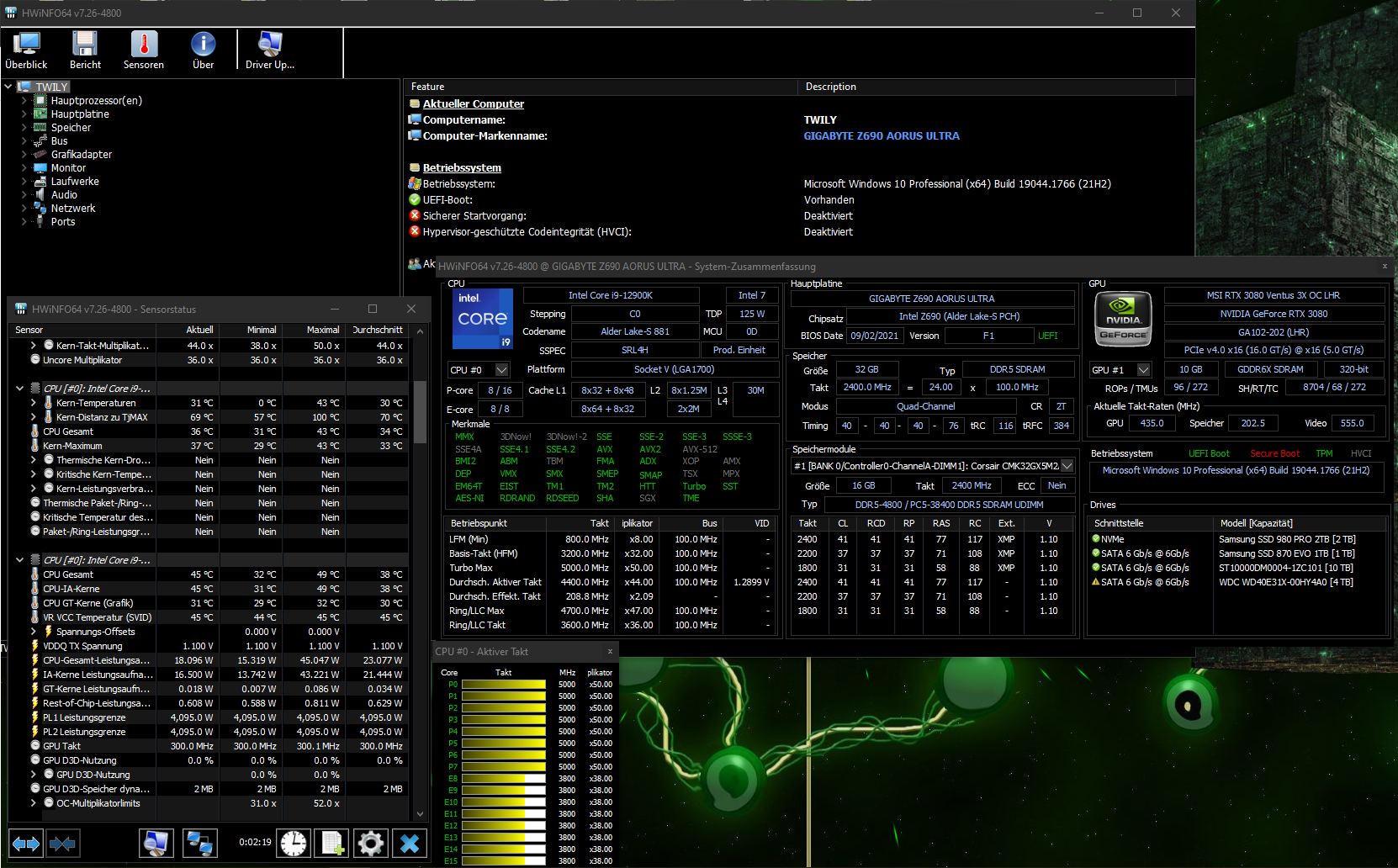My 12900-K is instantly jumping to 100°C in Cinebench.
In some games Temps jumped to 80°C for a short time (just starting e.g.).
However I observed this now during summer time, when my Room is heating up quite a bit. On the other side I have a mobile air conditioning unit cooling my room when I deem it to be to hot.
This is my first PC build btw.
Have the system running since Let's say late February/ early March.
Another scenarios:
Playing Cyberpunk 2077 in a rather hot room. -> No problems. Atleast it stays under 80°C (else I get a warning popup).
Playing VR games -> Also no problems. Even on hot days with my room heating up.
But when I (just for fun) ran Cinebench 23.2 it immediatly jumped to 99°C (I guess that's highest amount the "Thermal Console" from Gigabyte goes). This time my room was rather cold.
Do I have to worry? Because I would expect with 2 rads and 10 Fans that even a 12900-K does not hit critical Temps in an instant.
I did not do anything yet to resolve that problem.
At one point I had a Kink in my Loop. Also my pump was set to run at linearly before I changed it. When I fixxed the kink, I also installed a flowmeter (spinning wheel thingy that shows water is moving).
I found out, that water was NOT moving. This was during winter, So I didn't had problems with CPU - temp.
When I fixxed the kink, I also made the pump run at 20% when under 20°C, at 80% if under 30°C, 90% if under 46°C and 100% if above.
The water is flowing.
Neither the CPU-block nor the GPU-block have Air bubbles. Can't see any in the tubes. Again system running for quite a while now.
So... do I have to worry? Can I run a 10min. Cinebench Test with my CPU at 99°C without causing harm to it?
My Specs:
Pump -> GPU -> 420mm Rad with Exhaust Fans located on top (top mounted) -> CPU -> Side Radiator 360mm with 3x120mm Fans Intake -> Pump.
Pump is set to run at 100% as soon as temps hit 50°C
Pictures:
https://prnt.sc/fNwqATSjM2Xt
 https://prnt.sc/LJzmbQk8HhWi
https://prnt.sc/LJzmbQk8HhWi

Video:
https://drive.google.com/file/d/1Uj8XynYVJvBMrFl08xNX_9nU0A78fff_/view?usp=sharing<
https://drive.google.com/file/d/1Ggi6SUxMEk_-O8APoLmlyBHD8ys_ltih/view?usp=sharing
In some games Temps jumped to 80°C for a short time (just starting e.g.).
However I observed this now during summer time, when my Room is heating up quite a bit. On the other side I have a mobile air conditioning unit cooling my room when I deem it to be to hot.
This is my first PC build btw.
Have the system running since Let's say late February/ early March.
Another scenarios:
Playing Cyberpunk 2077 in a rather hot room. -> No problems. Atleast it stays under 80°C (else I get a warning popup).
Playing VR games -> Also no problems. Even on hot days with my room heating up.
But when I (just for fun) ran Cinebench 23.2 it immediatly jumped to 99°C (I guess that's highest amount the "Thermal Console" from Gigabyte goes). This time my room was rather cold.
Do I have to worry? Because I would expect with 2 rads and 10 Fans that even a 12900-K does not hit critical Temps in an instant.
I did not do anything yet to resolve that problem.
At one point I had a Kink in my Loop. Also my pump was set to run at linearly before I changed it. When I fixxed the kink, I also installed a flowmeter (spinning wheel thingy that shows water is moving).
I found out, that water was NOT moving. This was during winter, So I didn't had problems with CPU - temp.
When I fixxed the kink, I also made the pump run at 20% when under 20°C, at 80% if under 30°C, 90% if under 46°C and 100% if above.
The water is flowing.
Neither the CPU-block nor the GPU-block have Air bubbles. Can't see any in the tubes. Again system running for quite a while now.
So... do I have to worry? Can I run a 10min. Cinebench Test with my CPU at 99°C without causing harm to it?
My Specs:
- Case Corsair 7000D AIRFLOW
- Motherboard: Gigabyte Z690 AORUS Ultra
- 12900-K (obvsl.)
- MSI 3080 Ventus 3X 10G OC
- RAM: CORSAIR Vengeance DDR5 32GB (2x16GB) DDR5 4800 (PC5-38400) C40 1.1V - Black
- Pump: Hydro X Series XD5 (Corsair)
- One 420mm Radiator with 3x140mm Fans as Exhaust (Top) (Hydro X Seires XR5 420mm-Radiator)
- One 360mm Radiator with 3x 120mm Fans as Intake (Side) (Hydro X Seires XR5 360mm-Radiator)
- Another 4x140mm Fans (1 is Exhaust on the back and the other 3 are Intake Front)
Pump -> GPU -> 420mm Rad with Exhaust Fans located on top (top mounted) -> CPU -> Side Radiator 360mm with 3x120mm Fans Intake -> Pump.
Pump is set to run at 100% as soon as temps hit 50°C
Pictures:
https://prnt.sc/fNwqATSjM2Xt


Video:
https://drive.google.com/file/d/1Uj8XynYVJvBMrFl08xNX_9nU0A78fff_/view?usp=sharing<
https://drive.google.com/file/d/1Ggi6SUxMEk_-O8APoLmlyBHD8ys_ltih/view?usp=sharing
Last edited:


